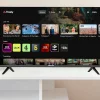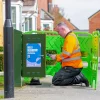Gov Detail BIG Changes to Boost UK Full Fibre Broadband and 5G UPDATE5
The UK government has today set out a range of new proposals (copper switch-off, regulatory reforms etc.) as part of their Future Telecoms Infrastructure Review (FTIR), which seeks to help boost investment and support for future 5G mobile and “full fibre” (FTTH/P) ultrafast broadband. But there are caveats.
At present a combination of new regulation stemming from Ofcom’s recent Strategic Review (details) and support from the government, such as via a 5 year business rates holiday on new fibre optic lines, improvements to the Electronic Communications Code (here) and several large investment / funding schemes to support 5G or “full fibre” development (here), are already having an impact.
The government recently made clear that they want 15 million premises to have access to Gigabit capable Fibre-to-the-Premises (FTTP) by 2025 and then nationwide to all by 2033 (here), although the latter date would require a huge public investment and is currently just a vague aspiration (i.e. responsibility for 2033 is likely to fall on the shoulders of a future government, which may have other plans).
Advertisement
One often overlooked fact here is that, thanks partly to the Broadband Delivery UK programme, rural areas currently have proportionally more FTTP than urban ones but this will soon change. Otherwise only around 4% of the UK (1.2 million premises) are able to access a pure fibre optic broadband ISP connection, but Ofcom now predicts that this could reach 20% by 2020 (due to the above schemes and changes etc.).
For example, over the past year Hyperoptic has said that it aims to cover 2 million urban premises with FTTH/P by 2022 (aspiration for 5 million by 2025), while Vodafone with Cityfibre will reach 1 million by 2021 (aspiration for up to 5 million by 2025) and Virgin Media plan 2 million by around 2019/20 (see our ‘Summary of Full Fibre Broadband Plans and Investment‘).
Not to mention all of the work by smaller operators and Openreach’s (BT) own plan for 3 million premises by 2020 (aspiration for 10 million by c.2025). TalkTalk is also proposing something similar. Suffice to say that progress is being made but so far this has been predominantly focused upon tackling the more commercially viable urban areas (i.e. the low hanging fruit).
The Problems
As usual the problems really begin when operators try to expand such services into less economically viable areas (suburban and rural), particularly the final 20% of premises (or wherever the commercial model begins to become unviable). This would require significantly more public funding (billions) and possibly a big shift in regulation.
Advertisement
Today’s report agrees that the final c.20% of the country is “likely to require bespoke solutions to ensure rollout of networks.” On top of that it adds that nationwide availability of full fibre is likely to require “additional funding” of around £3bn to £5bn to support commercial investment in the final c.10% of areas (we see this is a very conservative estimate for public funding and that’s assuming the private sector will try to match it).
In terms of the required changes, Openreach want to switch-off and migrate customers from their old copper network as FTTP is deployed in order to save money and make the investment more attractive. But doing this would be complex (see here) and will raise competition concerns from ISPs that have invested in copper (e.g. TalkTalk, Sky Broadband). Consumers may also be asked to pay more for the FTTP service and will need new phone adapters, which they might not all want (it’s a thorny issue).
At the same time wayleave agreements for land / property access can still be tricky to agree, even with the recent ECC changes (many landowners aren’t happy with being asked to accept a lower rental than before). In other cases it can also be difficult for ISPs to identify who owns a big building in urban areas (e.g. MDU apartments), which makes it hard to even start a conversation about deploying FTTP.
The fact that the business rates holiday on new fibre will come to an end in 4 years’ time is another concern and some would like to see it extended until the roll-out completes. On top of that there have long been calls for the system of securing planning permission and permits to be simplified and streamline, not least since different local authorities tend to set their own rules and that can disrupt roll-out plans.
Advertisement
Furthermore some operators would perhaps welcome extra protection for their investment, not least in order to reduce the risk of overbuild by competitors, which might help to make the economic model more viable, particularly in some of the most challenging areas (rural etc.) where building lots of competing FTTP makes little sense.
Another problem is one of manpower and skills or lack thereof. At present there are a fair few contractors around but many don’t have the necessary skills or equipment (e.g. narrow trenching) in order to deliver such a network in the right way and on schedule.
Suffice to say that today’s report tackles some but not all of these problem areas.
The Future Telecoms Proposals
Forget about the last generation of so-called “superfast broadband” (24Mbps+) services because today is all about how the market needs to change in order to foster the next generation of Gigabit (1000Mbps+) capable full fibre infrastructure, which doesn’t suffer from the same caveats to reliability and performance that have afflicted copper.
The proposals today are thus designed to create a long-term foundation for the delivery of such infrastructure, which will also be needed to fuel forthcoming Gigabit capable 5G Mobile networks from 2020 onwards. In keeping with that the Government has put several core recommendations on the table.
Simplified Summary of Key Proposals
* New legislation that will guarantee full fibre connections to new build developments (i.e. changes to streamline wayleaves and mandate fibre connections);
* Providing Operators with a ‘right to entry’ to flats, business parks, office blocks and other tenanted properties to allow those who rent to receive fast, reliable connectivity, from the right supplier at the best price;
* Reforms to the regulatory environment for full fibre broadband that will drive investment and competition and is tailored to different local market conditions. For example, the Gov will pursue an “outside-in” strategy, meaning that while network competition serves the commercially viable areas, the Government will support investment in the most difficult to reach areas at the same time. “We have already identified around £200 million within the existing Superfast broadband programme [BDUK] that can further the delivery of full fibre networks immediately.”
* Public investment in full fibre for rural areas to begin simultaneously with commercial investment in urban locations;
* An industry led switchover (from copper to full fibre) coordinated with Ofcom. The switchover process will be industry-led and timing will be dependent on the pace of rollout of fibre networks, and on the take-up of those networks. The report states it is realistic to assume that switchover could happen in the majority of the country by 2030.
* A new nationwide framework which will reduce the costs, time and disruption caused by street-works by standardising the approach across the country;
* Increased access to spectrum for innovative 5G services.
* Infrastructure (including pipes and sewers) owned by other utilities such as power, gas and water, should be easy to access, and available for both fixed and mobile use [ISPr NOTE: Many sewers are too unstable and pipes too difficult to use for this purpose but it’s useful to have the option, although this is already possible in some areas and a few ISPs have made use of it].
* Ofcom to reform regulation, allowing unrestricted access to Openreach ducts and poles for both residential and business use, including essential mobile infrastructure [ISPr NOTE: Arguably the bulk of this is already taking place under Ofcom’s recent Strategic Review – Duct & Pole Access];
* Alongside the review, Government has also published a Digital Infrastructure Toolkit which will allow mobile networks to make far greater use of Government buildings to boost coverage across the UK.
* The EU’s new directive for electronic communications – the European Electronic Communications Code (EECC) – is currently under negotiation. It is likely to be adopted by the EU shortly. If adopted, we are minded to implement, where appropriate, the substantive provisions in UK law, on the basis that it would support UK’s domestic policy objectives. This will enable the extension of market review periods to five years and provide mechanisms to aid fibre network rollout in certain areas.
* The Government said it is “not persuaded” that ‘overbuild’ should be discouraged in order to roll out full fibre, but they have promised to engage with BT and Ofcom to discuss the “effect that greater transparency [of build plans] might have on accelerating commercial network roll out.” For example, Openreach could publish in advance an agreed medium-term plan of the areas in which it is planning to roll out its fibre network (suitably redacted for commercially sensitive information on the costs and revenues of roll out). Any approach should allow Openreach to roll out its FTTP network wherever it is profitable to do so.
The strategy broadly seeks to recognise differences across rural and urban areas, and develops solutions that are tailored to both. The Review concludes that the “best approach is to promote competition and commercial investment wherever possible, and to intervene only where necessary.”
The Government added that they will shortly publish consultations on legislative changes to streamline wayleaves and mandate fibre connections in new builds. The conclusions of the Review will also form the basis of the government’s Statement of Strategic Priorities (SSP) to Ofcom, setting out the strategic objectives and outcomes that the regulator must have regard to in the exercise of its regulatory functions.
Jeremy Wright, New UK DCMS Secretary of State, said:
“We want everyone in the UK to benefit from world-class connectivity no matter where they live, work or travel. This radical new blueprint for the future of telecommunications in this country will increase competition and investment in full fibre broadband, create more commercial opportunities and make it easier and cheaper to roll out infrastructure for 5G.”
Sharon White, Ofcom CEO, said:
“We welcome the Government’s review, and share its ambition for full-fibre and 5G networks to be rolled out right across the UK. The Government and Ofcom are working together, and with industry, to help ensure people and businesses get the broadband and mobile they need for the 21st century.”
Sadly there’s no mention of any plans or even so much as a hint of desire to extend the business rates relief on new fibre beyond its current deadline. Meanwhile, the government’s indication that it will put £200m from the existing Broadband Delivery UK programme toward full fibre is largely just reflecting what we’ve already seen from the Phase 3 contracts, which are deploying a lot more FTTP in the final phase.
Plenty of gainshare and efficiency savings (i.e. reinvestment of public funding) from the earlier BDUK contracts will help to support this (£200m is similar to the current efficiency savings figure). Today’s report also notes that BDUK had helped to make FTTP available to over 200,000 premises in predominantly rural areas by March 2018, which I think is the first time we’ve seen a clear split for that figure.
The 2033 goal for “full fibre” and estimated 2030 copper switch-off also raises a question mark over the fate of Virgin Media’s Hybrid Fibre Coax (EuroDOCSIS) based cable network, which with the forthcoming DOCSIS 3.1 upgrade should be perfectly capable of handling Gigabit broadband speeds.
Strictly speaking there isn’t a pressing need for Virgin to replace all their coax with FTTP as that would not make much sense and we question whether they could afford it. We haven’t yet had a chance to read the full report but a quick scan suggests it hasn’t even considered this point. Likewise the full fibre goal represents bad news for fixed wireless broadband ISPs, which could slowly see their market wiped out unless they go fibre.
Elsewhere the report also, perhaps mercifully, appears to rule out the contentious and complex idea of regional franchises (see here for more). “This would require significant legislative change to deliver, leading to implementation delays and impacting the pace of roll out. Meanwhile, the market would likely take a wait-and-see approach when deciding whether to invest, potentially freezing investment for a number of years,” said the report.
An Openreach Spokesperson said:
“We’re encouraged by the Government’s plan to promote competition, tackle red tape and bust the barriers to investment. As the national provider, we’re ambitious and want to build full fibre broadband to 10 million premises and beyond – so it’s vital that this becomes an attractive investment without creating digital inequality or a lack of choice for consumers and businesses across the country. As the Government acknowledges, the economics of building digital infrastructure remain challenging for everyone, and we believe a review of the current business rates regime is necessary to stimulate the whole sector.
We want everybody in the UK to have fast, reliable access to the internet and we’re actively working on ways to increase adoption of our superfast and ultrafast services across the country. As more and more devices, appliances and services go online, we want every home and business to be able to do whatever they want, whenever they want online, all at the same time.
We’re already building full fibre to around 10,000 homes and businesses every week, and by 2020 we’ll have reached 3 million.
We have a huge, world class engineering team and wherever we build, we’ll deliver the best quality network with the highest levels of service and built-in competition and choice.
We’re determined to be the dependable partner for Government, the industry and our 600 wholesale customers as we work to bolster Britain’s position as a global digital leader.”
Admittedly it’s still possible that home broadband delivery could fundamentally change with the arrival of 5G based fixed wireless connections, much of which would need to be fed by fibre optic lines but which could deliver Gigabit speeds to end-users without needing to run that fibre all the way to each individual property (costly). Suffice to say that banking purely on FTTH may not be the most efficient use of future funding.
At the same time many of the ideas being proposed today would require another round of significant regulatory change, which is rarely a simple process. Getting ISPs to agree is often akin to herding angry cats and there’s also a strong need for politicians to plan beyond a single parliamentary term, which tends to require some degree of cross-party support (not easy in the current climate of sharp ideological divisions).
Future Telecoms Infrastructure Review
https://www.gov.uk/government/publications/future-telecoms-infrastructure-review
We’ve pasted the full list of recommendations below, which contains some extra detail for those who like to dig a bit deeper.
Full FTIR Recommendations
Full fibre connectivity
Reducing costs and barriers to deployment
• The Government will consult on new legislation to reform existing wayleaves arrangements – to provide a ‘right to entry’ for communications providers – and ensure full fibre connections to new build developments.
• The Government will streamline the permits regime and introduce best practice and guidance toolkit for street works.Promoting market entry and expansion for new network operators
• The Government will continue to work with Ofcom to ensure that Openreach cooperates fully with DPA requirements to open up its passive infrastructure. If the evidence shows that this remedy is not being implemented properly, the Government will consider all options with Ofcom to ensure compliance.
• Where ducts and poles are not available or ineffective, the Government will encourage Ofcom to consider other options to enable market entry by alternative networks, including dark fibre access.
• The Government will carry out a review of Communications (Access to Infrastructure) Regulations 2016 by 2019 to assess if there are improvements that could be made to further boost investment in infrastructure.
• Ofcom should work collaboratively with other regulators to ensure that multi-utility passive sharing opportunities are explored, and barriers addressed.
• The Government will continue to build on the successes of existing programmes to stimulate demand for fibre services, including actively considering full fibre solutions when purchasing government services.Stable and long-term regulation that incentivises competitive network investment
• The Government’s overarching strategic priority is to promote efficient competition and investment in world-class digital networks. The Government’s view is that promoting investment should be prioritised over interventions to further reduce retail prices in the near term, recognising these longer-term benefits.
• The Government has identified a set of outcomes with a view to achieving this strategic priority:
– The Government believes that a move to longer, five year review periods could provide greater regulatory stability and promote investment.
– The Government would encourage Ofcom to publish guidance that clearly sets out the approach and information it will use in determining a ‘fair bet’ return.
– The Government’s view is that regulatory forbearance is considered by Ofcom in developing its regulatory approach to incentivise the roll out of full fibre networks.
– The Government’s view is the regulatory framework should provide reassurance that the interests of consumers are safeguarded as fibre markets become more competitive.
– For areas where there is actual or prospective effective competition between networks, Government would not anticipate the need for regulation. For other areas, we would expect the regulatory model for to evolve over time as networks are established. If market power emerges, regulated access (including price controls) may be needed to address competition concerns. These detailed regulatory decisions will be for Ofcom to take.• For areas where there may not be commercial investment, even when commercially viable:
– The Government will consider using ‘competition for the market’ mechanisms to secure deployment, including new powers under the EECC.
– The Government will discuss with BT and Ofcom how transparency measures might be introduced.• The Government is determined to work with Ofcom, communication providers, and other key stakeholders such as consumer groups to improve overall customer service in telecoms, drive up standards and ensure that the consumer environment supports our full fibre ambitions. The Government will be considering the responses to the Consumer Green Paper that consultation and what further steps it needs to take to ensure that consumer markets, including the telecoms market, work for all, both now and in the future.
Ensuring world class connectivity for all
• The Government will pursue an ‘outside in’ strategy to support deployment of full fibre to the commercially most difficult to reach premises, likely to be around 10% of the total (approximately 3 million premises), starting at the same time as the market deploying to commercially viable areas.
• We will use competitive tenders to award contracts for these areas to commercial operators, in order to minimise any public subsidy requirements and ensure fairly priced services.
• The Government has already identified around £200 million within the existing Superfast Programme that can further the delivery of full fibre networks.
• The Government will also ensure that programmes delivered through the National Productivity Investment Fund (NPIF) are consistent with the objective of deployment of full fibre across the country.
• The Government and Ofcom will consider further how our ambitions for fibre deployment can complement existing programmes including the roll out of the broadband Universal Service Obligation (USO) from 2020 to maximise investment in full fibre.
• The Government will determine the longer-term options for funding rural connectivity as part of the forthcoming Spending Review process.Supporting the timely switchover to new full fibre networks
• Switchover should be led by industry, working closely with Ofcom and Government. The Government will set up a mechanism with Ofcom and industry to plan switchover.
• Switchover should meet a number of clear policy conditions:
– Plans support a timely switchover;
– Efficient, so that switchover is smooth with minimal consumer disruption;
– Transparent, so that customers have the information they need to make informed choices and clearly signalled via notice periods so operators have certainty;
– Consistent, with existing regulatory and consumer obligations;
– Pro-competitive, so processes are in place to support easy switching between networks; and
– A fair deal for consumers and adequate safeguards for vulnerable customers.• Ofcom will continue to have a role in ensuring that switching processes are easy and reliable for consumers, where customers switch between ISPs on different fibre networks.
Legal separation of Openreach from BT
• The Government wants legal separation to be completed as soon as possible and for Openreach to address all outstanding actions, particularly the transfer of staff from BT to Openreach.
• The Government will consider all additional measures if BT Group fails to deliver its commitments and regulatory obligations and if Openreach does not deliver on its purpose of investing in way that responds to the needs of its downstream customers.A world leader in 5G
Make it easier and cheaper to deploy mobile infrastructure
• The Government recognises the need to keep planning regulation under review and will continue to work with the sector to promote take-up of the wide range of planning reforms brought forward and to understand where the current planning regime could further support the deployment of digital infrastructure.
• The Government, as a major landlord in the UK, will open up its own estate to support the deployment of mobile infrastructure wherever possible.
• The Government will consider undertaking a formal review of the ECC reforms to assess their impact in 2019.
• The Government will work with industry to understand their concerns and explore whether there are additional ways to support collaboration between utility providers and communications providers to deliver connections to energy infrastructure in as timely and cost-effective manner as possible.
• The Government’s new Local Connectivity Group – bringing together local areas, industry and landowners – will publish best practice guidelines relating to the deployment of digital infrastructure at the local level by the end of the year.Supporting infrastructure models that promote competition and investment in network densification and extension
• The Government would like to see all future concession awards giving greater priority to the proposed investment plans and quality of the mobile infrastructure provision of the bidders.
• The Government intends to use the 5G Testbeds and Trials programme to trial a range of infrastructure models.
• The Government’s new Local Connectivity Group will help to develop best practice in awarding concessions.Stimulating demand and new use cases through the 5G Testbeds and Trials Programme
• The Government’s £200 million 5G Testbeds and Trials programme will fund projects to explore different connectivity solutions and business models for 5G.
• The next phase of the Programme will be a major urban connected community project.Securing a diverse set of innovative 5G services through spectrum policy
• The Government wants Ofcom to complete the award of the remaining 5G spectrum bands of 700 MHz and 3.6 – 3.8 GHz in a timely manner.
• The Government would like Ofcom to assess the feasibility and costs and benefits of potential flexible licensing models as part of its planned release of spectrum in the 3.6 – 3.8 and 3.8 – 4.2 GHz bands.
• The Government will ask Ofcom to report on the utilisation of spectrum in mobile bands.
• The Government would like Ofcom to provide clarity that leasing of mobile spectrum is not prohibited, to promote greater liquidity in the spectrum trading market.Convergence of networks and markets
• The Government’s view is that the policy and regulatory framework should be sufficiently flexible and forward-looking to reflect the growing convergence between fixed and mobile networks and services. This could be achieved through:
• Removing practical obstacles or barriers to converged networks;
• Recognising convergence and considering access network requirements holistically, through unified market reviews; and
• Allowing operators to benefit from unrestricted usage of Openreach’s passive infrastructure for the provision of mobile backhaul services.
• Government would like network operators and mobile operators, working with local authorities and other relevant parties, to engage on the likely locations for 5G cell sites, for the purpose of ensuring that fibre networks can be future-proofed.
• Government will ensure that existing programmes, in particular 5G Testbeds and Trials and LFFN, promote investments that recognise convergence, and use the new Local Connectivity Group to share information from these programmes more widely.
UPDATE 9:52am
The first comments are starting to come in.
TalkTalk CEO, Tristia Harrison, said:
“We agree with Government that a competitive market is the best way to deliver Britain’s full fibre future. If implemented well, this practical package of measures could make it easier and cheaper to roll out the world class broadband Britain needs. Full fibre networks are only viable with high take-up, so we welcome the Government’s clear support for low prices that make full fibre affordable for all.”
Mark Collins, Director of Strategy at CityFibre, said:
“Today marks the day the Government decided once and for all to leave copper behind and commit the UK to a full fibre future, making clear that a new generation of infrastructure builders is the vehicle for delivering its bold ambition for all homes and businesses to be connected to full fibre by 2033, not just Openreach. CityFibre is already building the networks that the UK’s economy needs to prosper and is ready to work with industry and Government to make this a reality quickly.
The Government’s plans to deliver nationwide full fibre include a welcome commitment to creating a level-playing field, ensuring greater transparency from the incumbent and delivering a stable regulatory environment for investment. However, it is critical that the consumer is at the heart of this fantastic opportunity from the start, as this is the key to unlocking demand. That means avoiding price rises, ensuring switching between networks is simple and ending the years of misleading ‘fake fibre’ advertising. Getting both sides of the equation right is key to ensuring millions of homes and businesses will benefit – we now need to see the Government and Ofcom push these plans through.”
Sir John Armitt, Chairman of the National Infrastructure Commission, said:
“Our National Infrastructure Assessment highlighted the real benefits that full-fibre broadband could offer this country’s households and businesses – and the real risk that rural and remote communities could miss out.
So I welcome the findings of today’s Future Telecoms Infrastructure Review, which mirror our own recommendations and will ensure that every community will benefit from these faster, more reliable connections.
As well as broadband, this plan will also leave the UK well-placed to introduce the latest 5G mobile technology wherever people live, work and travel.”
Evan Wienburg, CEO of Rural FTTP ISP TrueSpeed, said:
“We welcome the Government’s statement today that a switchover from hybrid to full fibre networks could be underway in the majority of the country by 2030. But the devil is in the detail.
While the Government is right to state that a full-throttle drive to nationwide full fibre connectivity requires competition and commercial investment to succeed, a fair and equitable playing field for all infrastructure providers is essential. This has not always been the case. There are numerous examples of tax payers’ money being wasted by national incumbent providers building FTTC/FTTP networks in areas where privately funded infrastructure providers have already deployed.
We urge the Government to engage more closely with industry in the drawing up of the regulatory and policy changes mooted in the report. And to do this fast. Swift decision making is of the essence if the UK is to have the digital future it deserves.”
UPDATE 10:49am
More comments.
Hamish MacLeod, Director at Mobile UK, said:
“Mobile UK is encouraged by the focus on reducing mobile deployment costs in the Government’s Future Telecoms Infrastructure Review. We welcome its acknowledgement for the need to work in partnership with industry and the priority now must be to make concrete and rapid progress to ensure the UK is at the forefront of the next generation of digital connectivity.
The review builds on key requests made by mobile operators for reform, including: further planning reform; improved access to public sites; innovative local partnerships with local authorities; and the effective implementation of the reformed Electronic Communications Code to make it easier and cheaper to roll-out mobile infrastructure. We look forward to the Government working with industry to bring about these reforms quickly.”
Andrew Glover, Chair of ISPA, said:
“The broadband sector is at an exciting intersection and ready to be propelled into the next full fibre phase of its development. It will be crucial for industry to work collaboratively and in close consultation with Government and Ofcom to further identify how the sector can be best stimulated to deliver the future-proof infrastructure the country needs.
We particularly look forward to working further with Government to remove barriers to broadband rollout, the single most important lever policymakers can use to accelerate the rollout of infrastructure”.
UPDATE 12:38pm
Yet more comments. We have also asked for feedback from Virgin Media but so far they haven’t responded.
Dr Charles Trotman, CLA (Landowners), said:
“We welcome the Government’s intention to connect hard-to-reach rural areas. The future of the rural economy depends on fast, affordable and reliable connections. However, we need to see fully developed details from the Government as to why the full fibre broadband rollout should take 15 years to complete and where the money is coming from.
Many rural areas fall short of a 4G service due to the inability of mobile network operators to resolve poor signal and mobile not-spots. Rural business must not be side-lined. It is vital that 4G coverage is put in place first because a future 5G service relies on 4G infrastructure.
“We support the Government ambition to deliver mobile coverage to 95% of UK geographic landmass by the end of 2022. One of the ways to do this is to hold to account mobile phone operators to ensure they invest in a better connected countryside. By engaging all of the industry in the process and ensuring landowners’ rights are fairly balanced, we can finally ensure 4G for all.”
We note Trotman’s remark about being seemingly confused as to why the rollout of full fibre should take 15 years to complete, which should be pretty obvious given all of the extensive civil engineering involved and high cost of labour + limited supply of skilled labour. The time-scale is by no means unique to the UK, it’s a similar story in pretty much every country (possibly excluding communist states) that has been deploying FTTH/P.
Dana Tobak, CEO of Hyperoptic, said:
“As the UK’s largest residential gigabit provider, we have a strong relationship with the DCMS and are firm believers in the Full Fibre strategy that the FTIR is aimed at driving. We broadly support the recommendations, especially its fundamental policy of encouraging infrastructure competition within the market.
However, the devil will be in the detail and delivery. For example, we welcome the review of the wayleave process to expedite full fibre rollout, but industry must not forget that wayleaves underpin the relationship between network builders and landowners to ensure safety and quality for residents, so we shouldn’t be too quick to undermine this.
While we note the comments about the switchover from copper to full fibre, we believe it’s more important to focus on easier switching between networks. To encourage competition (and therefore accelerate rollout), the government and Ofcom need to support easy switching for consumers and businesses between networks and not just on Openreach’s platforms – it’s an important success factor in competing networks.”
UPDATE 2:13pm
A useful comment has come in from the chair of the ITSPA, which covers the position of VoIP providers (very important for a FTTP world).
Eli Katz, Chair of ITSPA, said:
“In general, the proposals put forward by Government are welcome. The UK is lagging behind many other countries in terms of full fibre rollout and it is important that we step up now to remain competitive. Our members already see the benefits that full fibre brings where it is currently deployed; both in terms of new business as well as service offerings for their customers. The message is clear, there simply needs to be more of it!.
Whilst switching over to full fibre is definitely welcome, the Government and Ofcom needs to ensure that in doing so, they don’t hurt a thriving telco industry that has developed over the past few decades. A balance needs to be struck around existing regulations that were relevant in a PSTN world but are becoming increasingly less appropriate in an IP environment, where consumers and businesses are using services in a very different way.
Equally there are certain processes that need to be maintained, with IP alternatives developed before migration can be considered. Issues range far and wide; from battery backup for 999 access to developing an IP version of TDM Interconnect but all are important to ensure the industry is not unfairly damaged by an ill-thought out transition plan. We will be working with Ofcom and Government to ensure these concerns are clearly understood as we work towards a prosperous full IP future.”
UPDATE 3:50pm
Gigaclear’s turn to comment.
Mike Surrey, CEO of Gigaclear, said:
“As the UK’s largest rural full-fibre network operator, Gigaclear has been calling for the UK government to set out a national plan for full fibre delivery – today the DCMS has delivered on that.
The FTIR lays out the path for the future and for a copper switch-off that will not only provide confidence to full fibre investors and the operators they support, but also for consumers who struggle with inadequate infrastructure.
Wayleave reform, consistent street works rules and further funding to support rural areas should go a long way to accelerating full fibre delivery. Whilst the devil will be in the detail – today’s announcement marks a huge leap forwards into the UK’s full fibre future.”
Mark is a professional technology writer, IT consultant and computer engineer from Dorset (England), he also founded ISPreview in 1999 and enjoys analysing the latest telecoms and broadband developments. Find me on X (Twitter), Mastodon, Facebook, BlueSky, Threads.net and Linkedin.
« Cityfibre UK Joins European Alliance to Boost Full Fibre Broadband


















































Comments are closed